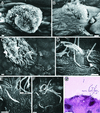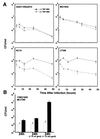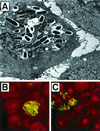Establishment of a persistent Escherichia coli reservoir during the acute phase of a bladder infection
- PMID: 11402001
- PMCID: PMC98534
- DOI: 10.1128/IAI.69.7.4572-4579.2001
Establishment of a persistent Escherichia coli reservoir during the acute phase of a bladder infection
Abstract
The vast majority of urinary tract infections are caused by strains of uropathogenic Escherichia coli that encode filamentous adhesive organelles called type 1 pili. These structures mediate both bacterial attachment to and invasion of bladder epithelial cells. However, the mechanism by which type 1 pilus-mediated bacterial invasion contributes to the pathogenesis of a urinary tract infection is unknown. Here we show that type 1-piliated uropathogens can invade the superficial epithelial cells that line the lumenal surface of the bladder and subsequently replicate, forming massive foci of intracellular E. coli termed bacterial factories. In response to infection, superficial bladder cells exfoliate and are removed with the flow of urine. To avoid clearance by exfoliation, intracellular uropathogens can reemerge and eventually establish a persistent, quiescent bacterial reservoir within the bladder mucosa that may serve as a source for recurrent acute infections. These observations suggest that urinary tract infections are more chronic and invasive than generally assumed.
Figures





References
-
- Barza M. Urinary tract. In: Schaeter M, Engelberg N C, Eisenstein B I, Medoff G, editors. Mechanisms of microbial disease. Philadelphia, Pa: Williams & Wilkins; 1998. pp. 564–572.
-
- Blattner F R, Plunkett III G, Bloch C A, Perna N T, Burland V, Riley M, Collado-Vides J, Glasner J D, Rode C K, Mayhew G F, Gregor J, Davis N W, Kirkpatrick H A, Goeden M A, Rose D J, Mau B, Shao Y. The complete genome sequence of Escherichia coli K-12. Science. 1997;277:1453–1474. - PubMed
-
- Blomfield I C, McClain M S, Eisenstein B I. Type 1 fimbriae mutants of Escherichia coli K12: characterization of recognized afimbriate strains and construction of new fim deletion mutants. Mol Microbiol. 1991;5:1439–1445. - PubMed
-
- Brauner A, Jacobson S H, Kuhn I. Urinary Escherichia coli causing recurrent infections–a prospective follow-up of biochemical phenotypes. Clin Nephrol. 1992;38:318–323. - PubMed
Publication types
MeSH terms
Grants and funding
LinkOut - more resources
Full Text Sources
Other Literature Sources
Medical

